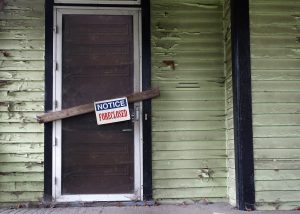 ATTOM’s latest Vacant Property and Zombie Foreclosure Report for Q2 shows that 1.3 million (1,304,007) residential properties in the nation currently sit vacant, representing 1.3% of all homes in the U.S., or one in 76 homes.
ATTOM’s latest Vacant Property and Zombie Foreclosure Report for Q2 shows that 1.3 million (1,304,007) residential properties in the nation currently sit vacant, representing 1.3% of all homes in the U.S., or one in 76 homes.
Among those pre-foreclosure properties, 7,569 sit vacant in Q2, meaning that the number of zombie foreclosure properties went up quarterly by 2.8%.
Zombie foreclosures refer to properties where a homeowner is presented with a pending foreclosure notice, and abandons their house before legally necessary, as the house slowly falls into disrepair and a state of dilapidation.
ATTOM’s report also found that 259,166 residential properties in the U.S. were in the process of foreclosure in Q2, up 12.7% from Q1, and up 15.9% year-over-year.
“The incidence of zombie-foreclosures tends to be higher in cases where the foreclosure process has dragged on for many months and sometimes even for years,” said Rick Sharga, EVP of Market Intelligence at ATTOM. “We’re now seeing properties where the borrower was already in default prior to the government’s moratorium re-enter the foreclosure process, and undoubtedly some of these homes will have been vacated over the past 26 months.”
The second quarter of 2022 marks the third consecutive quarter that the count of pre-foreclosure properties has gone up since a nationwide foreclosure moratorium, imposed early during the Coronavirus pandemic, and lifted nearly 12 months ago at the end of July 2021.
“According to our equity report, almost 90% of homeowners in foreclosure have positive equity,” Sharga noted. “Having equity gives financially-distressed homeowners an opportunity for a relatively soft landing–selling their home at a profit rather than losing everything to a foreclosure. That factor alone should keep the number of zombie foreclosures from rising too much.”
ATTOM noted the number of zombie foreclosures does remain down 6.3% from one year ago, and continues to represent just a small segment of the nation’s current inventory of 99.7 million residential properties. Just one of every 13,171 homes in Q2 were vacant and in some stage of foreclosure. The portion of pre-foreclosure properties that have been abandoned into zombie status also continues to decline, down from 3.6% a year ago to 3.2% in Q1 of 2022, and 2.9% in Q2 of this year. But the recent increase in zombie properties is the first since the moratorium ended. The portion of all residential properties sitting empty in the foreclosure process has grown 1.9% in Q2, up from one in 13,424 in Q1.
Among metropolitan statistical areas in the U.S. with at least 100,000 residential properties and at least 100 properties facing possible foreclosure in Q2, the highest zombie rates were found in:
- Peoria, Illinois, where 11.3% of properties in the foreclosure process were vacant;
- Wichita, Kansas, where 11.2% of properties in the foreclosure process were vacant;
- Cleveland, Ohio, where 9.5% of properties in the foreclosure process were vacant;
- Syracuse, New York, where 8.9% of properties in the foreclosure process were vacant; and
- South Bend, Indiana, where 8.6% of properties in the foreclosure process were vacant.
Among the 27.9 million investor-owned homes throughout the U.S. in Q2, approximately 905,000 were vacant (3.2% of the overall share). The highest levels of vacant investor-owned homes were found in the following states:
- Indiana with 6.9%;
- Kansas with 5.8%;
- Oklahoma with 5.3%;
- Alabama with 5.1%; and
- Ohio with 5.0%.
Among the roughly 3,300 foreclosed, bank-owned homes/REO properties in the U.S. during Q2, 10.8% were vacant. In states with at least 50 bank-owned homes, the largest vacancy rates were found in:
- Pennsylvania with 19.9% vacant;
- Indiana with 17.2% vacant;
- Texas with 16.4% vacant;
- Ohio with 16% vacant; and
- Illinois with 15.9% vacant.
The highest zombie foreclosure rates in U.S. counties with at least 500 properties in the foreclosure process during Q2 were found in:
- Broome County (Binghamton), New York with 11.8% of pre-foreclosure homes empty);
- Cuyahoga County (Cleveland), Ohio with 10.8% of pre-foreclosure homes empty);
- Onondaga County (Syracuse), New York with 9.4% of pre-foreclosure homes empty);
- Pinellas County (Clearwater), Florida with 9.3% of pre-foreclosure homes empty); and
- Oneida County, New York (outside Syracuse) with 8.3% of pre-foreclosure homes empty.
On the other end of the spectrum, the lowest zombie rates among counties with at least 500 properties in foreclosure in Q2 were found in:
- Contra Costa County, California (outside Oakland) with no pre-foreclosure homes reported as empty;
- Hudson County, New Jersey (outside New York) with 0.3% of pre-foreclosure homes reported as empty;
- Atlantic County (Atlantic City), New Jersey with 0.4% of pre-foreclosure homes reported as empty;
- Mecklenburg County (Charlotte), North Carolina with 0.5% of pre-foreclosure homes reported as empty; and
- Sacramento County, California with 0.6% of pre-foreclosure homes reported as empty.
Among 424 counties with at least 50,000 residential properties, those with the largest portion of total homes in zombie foreclosure status in Q2 were found in:
- Broome County (Binghamton), New York with one of every 648 properties;
- Cuyahoga County (Cleveland), Ohio with one in 933 properties;
- Peoria County, Illinois with one in 1,144 properties;
- Suffolk County (eastern Long Island), New York with one in 1,165 properties; and
- Oneida County, New York (outside Syracuse), with one in 1,437 properties.
Click here to view more of ATTOM’s Q2 Vacant Property and Zombie Foreclosure Report.
Read Full Article [Source: www.dsnews.com]




